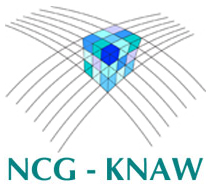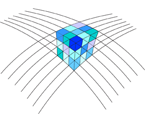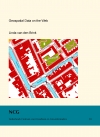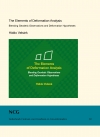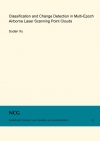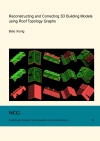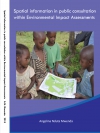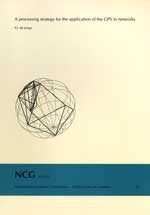
P.J. de Jonge
Publications on Geodesy 46, Delft, 1998. 240 pagina's.
ISBN-13: 978 90 6132 266 5. ISBN-10: 90 6132 266 9.
Summary
The objective of this thesis is the development of a geodetic data reduction model for the use of the GPS for high precision relative positioning, with an emphasis on static network applications. The following aspects can be distinguished: optimum use of available data, estimability of parameters the use of an efficient estimation method for the estimation of both the continuous and integer parameters, and the development of an efficient testing procedure to detect gross errors in the data.
To enable the optimum use of the collected data we use the original observables instead of the more common use of (double) differenced observables. This also enables the estimation of parameters (receiver and satellite clocks) eliminated in the differencing approach. Instead of the common use of linear combinations of the GPS observable types, we use the original observable types. Again this enables the estimation of parameters otherwise eliminated (ionospheric slant delays) and guarantees that the full information contained in the observables is preserved. Since, when using the original observables, the models for GPS relative positioning are not of full rank, the rank defect is analyzed and resolved, and resulting estimable functions are given. In particular, an algorithm for resolving the rank defect due to the GPS carrier phase ambiguities is described.
The use of the original observables asks for an efficient data reduction model. The data reduction is therefore carried out in two steps. In the first step the local parameters, viz. clocks and ionospheric slant delays are eliminated and only the global parameters (coordinates,
tropospheric zenith delays, ambiguities) are estimated using Cholesky factorization of the sparse, reduced normal matrix. For the ordering of the global parameters during the factorization an a priori ordering is given which to a large extent preserves sparsity. In the second step the local parameters are computed, and the (sometimes tens of thousands) observations are efficiently tested for gross errors (outliers and cycle slips). The testing of observations lacks in the existing GPS data processing softwares for networks. The data reduction for the original observations does in general not cost more time than the reduction for the double differenced observations, and besides enables the quality analysis of single observations instead of functions thereof.
For high precision relative positioning the integer estimation of the GPS phase ambiguities and subsequent constraining of the ambiguities at their integer values (fixed solution) is needed. The integer estimation is carried out using the LAMBDA (Least-squares AMBiguity Decorrelation Adjustment) method. It consists of a general decorrelation of the ambiguities materialized in a so-called Z-matrix, followed by a depth-first search in the hyper-ellipsoid formed by the variance-covariance matrix of the ambiguities. The construction of the Z-matrix (explicitly and implicitly) and the search are derived, and described in detail.
Results of the integer estimation are given for baselines up to 56 km, and for a small network with three of the four stations allowed to be moving. The integer estimation method was also applied to a regional network in California, set up for monitoring of crustal movements. The results show the applicability of the method to both short baselines (up to 10-20 km) with an observation time span of the order of seconds, and regional networks with station separation of up to hundreds of kilometers and an observation time span of the order of one day.
Contents
- Preface v
- Summary vii
- Samenvatting (in Dutch) viii
- List of symbols ix
- List of abbreviations xi
- Introduction 1
- Functional model for the GPS observables 7
- GPS relative positioning: the undifferenced approach 37
- Relative positioning using multiple GPS observable types 91
- Integer ambiguity estimation 141
- Ambiguity resolution at medium distances 183
- GPSveQ 209
- r8(t), r8(t), and r8(t) in ECEF WGS-84 211
- Inverting dTd 215
- Computation of HA2 and Q-1PA2 219
Samenvatting
Een verwerkingsstrategie voor de toepassing van het GPS in netwerken
De doelstelling van dit proefschrift is de ontwikkeling van een gegevensverwerkingsmodel voor het gebruik van het GPS voor zeer precieze relatieve plaatsbepaling, met een nadruk op de statische netwerktoepassing. In het onderzoek kunnen de volgende aspecten worden onderscheiden: optimaal gebruik van de data, schatbaarheid van de parameters, het gebruik van een efficiënte schattingsmethode voor zowel de reëelwaardige als de geheeltallige parameters, en de ontwikkeling van een efficiënte procedure om grove fouten in de waarnemingen te ontdekken.
Om optimaal gebruik van het waarnemingsmateriaal te waarborgen worden de originele waarnemingen in plaats van de vaak toegepaste dubbele verschillen van de waarnemingen gebruikt. Dit stelt ons tevens in staat om parameters te schatten die anders geëlimineerd worden (ontvanger- en satellietklokken). In plaats van de vaak toegepaste lineaire combinaties van GPS-waarnemingstypen, gebruiken we de originele waarnemingstypen. Dit maakt het weer mogelijk om parameters die anders geëlimineerd worden te schatten (ionosferische vertragingen), en garandeert het behoud van de volledige informatie aanwezig in de waarnemingen. Omdat voor de originele waarnemingen de modellen voor relatieve plaatsbepaling met GPS niet van volle rang zijn, wordt het rangdefect geanalyseerd, en worden resulterende schatbare functies gegeven. In het bijzonder wordt een algoritme voor de oplossing van het rangdefect veroorzaakt door de GPS fase meerduidigheden beschreven.
De gegevensverwerking wordt uitgevoerd in twee stappen. In de eerste stap worden de lokale parameters (klokken en ionosferische vertragingen) ge6limineerd waarna de overige parameters (coördinaten, troposferische zenit vertragingen, meerduidigheden) geschat worden met behulp van Cholesky factorisatie van de ijle, gereduceerde normaalmatrix. Voor de ordening van de parameters gedurende de factorisatie, wordt een a priori methode gegeven, die de ijlheid grotendeels behoudt. In de tweede stap worden de lokale parameters berekend en worden de (soms tientallen duizenden) waarnemingen op efficiënte wijze getoetst op grove fouten. De toetsing van waarnemingen ontbreekt in bestaande GPS verwerkingssoftware voor netwerken. De gegevensverwerking kost in het algemeen niet meer tijd dan die voor de dubbele verschilmetingen, en maakt een kwaliteitsanalyse van enkele waarnemingen in plaats van functies van waarnemingen mogelijk.
Voor zeer precieze relatieve plaatsbepaling, is geheeltallige schatting van de GPS fase meerduidigheden, en een daarop volgend vasthouden van de meerduidigheden op hun geheeltallige waarden, noodzakelijk. De geheeltallige schatting wordt uitgevoerd met de LAMBDA methode. Deze bestaat uit een decorrelatie van de meerduidigheden gevolgd door een zoekprocedure in de hyper-ellipsoïde gevormd door de variantie-covariantie matrix van de meerduidigheden. De constructie van de decorrelerende matrix (zowel expliciet als impliciet) en de zoekprocedure worden afgeleid en in detail beschreven.
Resultaten van de geheeltallige schatting worden gegeven voor basislijnen tot 56 km, en voor een klein netwerk met drie van de vier stations bewegend. De geheeltallige schattingsmethode is ook toegepast op een regionaal netwerk in Californië, opgezet om aardkorstbewegingen te bepalen. De resultaten laten zien dat de methode zowel toegepast kan worden voor korte basislijnen (tot 10-20 km) en een waarnemingstijdsspan van enkele seconden, als voor regionale netwerken met afstanden tussen stations van honderden kilometers en een tijdsspan van een dag.
